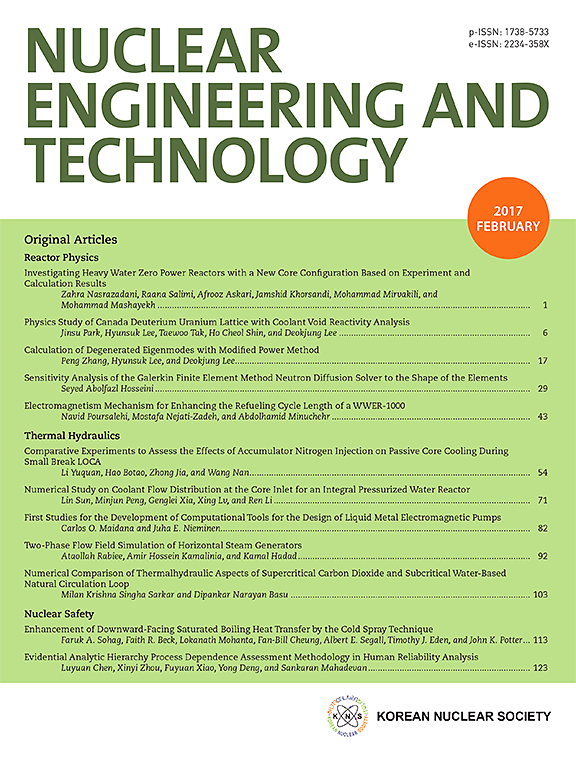改进用于杆束阵列子通道分析的宏观湍流模型
IF 2.6
3区 工程技术
Q1 NUCLEAR SCIENCE & TECHNOLOGY
引用次数: 0
摘要
PRIUS 程序的建立是为了生成 6 × 4 和 12 × 6 杆束几何形状的实验数据库。该数据库将用于进行建模和验证所需的子通道和 CFD 代码分析。这一点很有必要,因为小断裂损失冷却剂事故(SBLOCA)和中断裂损失冷却剂事故(IBLOCA)由于径向功率曲线、横流和扩散弥散,会在堆芯中产生三维现象。因此,特别是在堆芯再充水期间,需要特定的实验计划来研究大规模的三维效应。然而,由于无法在高压和高温蒸汽-水流动条件下安装仪器,因此无法在存在三维效应的情况下分别验证代码中的每个敏感模型。PRIUS 测试程序使用单相流测试来模拟非均质速度分布,并提供子通道之间具有径向混合效应的横流信息。使用宏观湍流模型的 CUPID 代码已通过 PRIUS-II 试验数据库进行了验证。此外,还验证了现有宏观湍流模型在不同入口流动条件下的预测能力。然而,验证结果表明,子通道之间的剪切区域存在明显误差。改进后的宏观湍流模型在预测多孔介质分析中的湍流动能方面显示出良好的效果。本文章由计算机程序翻译,如有差异,请以英文原文为准。
Improvement of macroscopic turbulence model for subchannel analysis in the rod bundle array
The PRIUS program was established to generate an experimental database for the 6 × 4 and 12 × 6 rod bundle geometry. The database will be used to address the subchannel and CFD code analysis required for modeling and validation. This is necessary because Small Break Loss of Coolant Accident (SBLOCA) and Intermediate Break Loss of Coolant Accident (IBLOCA) present three-dimensional phenomena in the core due to the radial power profile, crossflow, and diffusion-dispersion. Therefore, specific experimental programs are required, especially during core reflooding, to investigate the large-scale three-dimensional effects. However, validating each sensitive model of the code separately in the presence of 3D effects is not possible due to the inability to implement instrumentation at high pressure and temperature steam-water flow conditions. The PRIUS test program uses a single-phase flow test to simulate a non-homogeneous velocity distribution and provide information on crossflow with radial mixing effects between subchannels. The CUPID code, which uses a macroscopic turbulence model, has been validated using the PRIUS-II experimental database. Existing macroscopic turbulence models were also validated for their prediction capabilities with different inlet flow conditions. However, the validation revealed significant errors in the shear region between subchannels. An improved macroscopic turbulence model showed promising results in predicting turbulence kinetic energy in porous media analysis.
求助全文
通过发布文献求助,成功后即可免费获取论文全文。
去求助
来源期刊

Nuclear Engineering and Technology
工程技术-核科学技术
CiteScore
4.80
自引率
7.40%
发文量
431
审稿时长
3.5 months
期刊介绍:
Nuclear Engineering and Technology (NET), an international journal of the Korean Nuclear Society (KNS), publishes peer-reviewed papers on original research, ideas and developments in all areas of the field of nuclear science and technology. NET bimonthly publishes original articles, reviews, and technical notes. The journal is listed in the Science Citation Index Expanded (SCIE) of Thomson Reuters.
NET covers all fields for peaceful utilization of nuclear energy and radiation as follows:
1) Reactor Physics
2) Thermal Hydraulics
3) Nuclear Safety
4) Nuclear I&C
5) Nuclear Physics, Fusion, and Laser Technology
6) Nuclear Fuel Cycle and Radioactive Waste Management
7) Nuclear Fuel and Reactor Materials
8) Radiation Application
9) Radiation Protection
10) Nuclear Structural Analysis and Plant Management & Maintenance
11) Nuclear Policy, Economics, and Human Resource Development
 求助内容:
求助内容: 应助结果提醒方式:
应助结果提醒方式:


